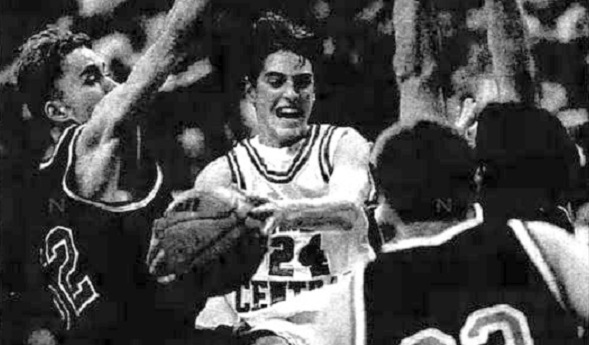
Hoops History Filled with District Stunners
By
Ron Pesch
MHSAA historian
March 9, 2018
The opinions expressed in the following are those of MHSAA historian Ron Pesch, and are not, necessarily, those of the folks who grant Pesch the chance to express them.
You are advised.
Life, sometimes, is unfair.
Despite healthy eating habits, lots of exercise, plenty of sleep, appropriate amounts of water, brain teasers, and blood pressure medicine – all those things that should, hopefully, extend a life – occasionally, our last breath arrives before the awarding of the gold watch or a trip to Disneyland.
The MHSAA Boys Basketball Tournament, sometimes, is like life. And that’s the way it should be.
The postseason is where all teams across the state are rewarded with a second chance, regardless of regular season win-loss record. In the thrilling one-and-done playoffs, highly ranked foes can be next-door neighbors or distant strangers; known only via rumor, newspaper rankings, or in these high-tech times YouTube clips. A knockout punch, ousting a team from the tournament, is most often delivered by a “worthy” opponent.
From time to time however, the end of the road arrives when least expected, via defeat by a less talented team vying for a cherished brand. “Underdog,” “Long Shot,” “Dark Horse” and “Cinderella” are the Nike®, Addias®, Reebok®, and Under Armour® of the unknown and under-achieving. Each brand is worn with pride. Everyone, including sportswriters, loves a sleeper.
In Michigan, with minor alterations, the MHSAA basketball postseason functions much as it always has operated. Champions are rare – by design, only four teams can finish the season with victory. Logistics and economics mean a team’s toughest opponent might arrive anywhere along the path. Districts are established based on schools of similar enrollment size found in logical geographic boundaries. District champions advance to play opponents in defined regions, and Regional winners move on to the final three rounds to determine those four statewide MHSAA champions. The state’s largest schools battle for the Class A title, while the smallest chase the Class D crown.
Therein lies the beauty. The playoff experience for today’s athletes is very much the same as it was for their fathers, their grandfathers and their great-grandfathers. The next opponent is luck-of-the-draw, based on a district line, and beyond a team’s control. Come game time, a blown breakaway, a bricked or air-balled jumper, or a rimmed shot that doesn’t fall can mean dreams of trophies, medals and glory, vanish from view. Tournament time does not discriminate. End game can happen to anyone.
Just like in daily life.
Sometimes, the toughest challenges arrive quicker than we feel they should. Within can be heartbreak, and, often, our greatest lessons.
Beware – the tournament tipped off again this week, and more than 120 District titles will be up for grabs tonight.
The MHSAA Tournament pre-dates Disneyland by 30 years. After assuming administrative control of high school sports in the fall of 1924, the Association made a move to expand the annual boys basketball tournament from three classifications to four with the addition of Class D in 1926.
Five years later, beginning in 1931, the public schools from the city of Detroit exiled themselves from the tournament. A year later, the schools in the Upper Peninsula did the same. Those moves, recent research shows, came from a general philosophy by local and national education authorities that there was an over-emphasis on competitive athletics. In the city of Detroit, the move meant a departure from statewide competition that would last for more than 30 years.
“The elimination of Upper Peninsula schools from state competition was the recommendation of its two (seats) on the (MHSAA representative) council,” came the report from the Lansing State Journal. “They deplored the long distances involved in sending teams from that section to the state tournament.”
Certainly, the depth of the nation’s Great Depression was a force that also insured distinct peninsula tournaments, at least in the earliest years of the separation. So, from 1932 through 1947, the MHSAA sponsored both Upper and Lower Peninsula tournaments, and crowned titlists on both peninsulas.
In 1941, and for nearly 20 years, the state’s smallest schools christened their own Class E champion. By far, the overwhelming majority were located in the vast Upper Peninsula, so it was a U.P.-only tournament.
Thereafter, a few twists of fate combined with population demographics to alter the shape of the event.
The number of schools, as well as their enrollments, played into the scheduling of action. For many years, Class A schools (as well as Class B schools for a few seasons), didn’t begin tournament play until the Regional round. Classifications were based on enrollment, with the state’s largest schools playing in Class A. Since there were relatively few Class A schools, when compared to Class C or Class D, fewer postseason games were required to identify a state champion for schools in the upper classifications. During the 1953-54 school year, there were 75 Class A schools, all in the Lower Peninsula. In Class B, there were 180 schools, (including 17 in the U.P.), while Class C included 246, (18 across the Straits). There were 181 Class D schools in the Lower Peninsula, (with 21 schools each in Class D and Class E in the U.P.). Hence, the path to a crown was, at least statistically speaking, more challenging for a smaller school.
With the post-war baby boom, and the growing size of the suburbs around the state, the first Class A Districts were held 60 years ago, in 1958. With that, the chase became more equal.
In 1961, for the first time, a Class A District tournament was held above the Straits. Played at Sault Ste. Marie, it included four teams, “with two U.P. teams, Sault and Escanaba, competing against two Lower Michigan quintets, Alpena and Traverse City,” according to the Ironwood Daily Globe.
In 1962, Detroit Public Schools ended their self-imposed exile and rejoined tournament play. With the return of those 20 schools, the first statewide prep tournament in 32 years now included 749 teams. Class A included schools with 900 or more students, Class B with between 400 and 899 pupils, Class C 200 to 399 and Class D for schools with enrollments of fewer than 200 students.
Beginning with the 2018-19 school year, basketball will move to divisions versus classifications, where the number of schools competing for a division title is uniform.
No. 1 Goes Down
Devastating District Defeats
It doesn’t happen often, but it does happen. Every now and then, Michigan’s top-ranked teams fall in the opening round of the MHSAA tournament.
1952 – Class C - Muskegon Western Michigan Christian 39, Muskegon St. Mary 36
Given little chance of surviving opening night Class C District play at Fremont High School, Muskegon Western Michigan Christian “had to do it the hard way, coming from behind with a last ditch rally that had the overflow throng on the edge of their seats.”
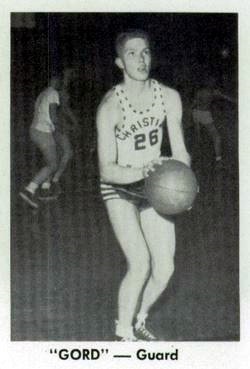 Twice beaten by St. Mary during the regular season, the Warriors opened a surprising 13-5 lead through the first quarter, behind the shooting of Gordon DeKruyter and Dave Bolema. The two seniors would end the game with high-scoring honors at 14 points apiece.
Twice beaten by St. Mary during the regular season, the Warriors opened a surprising 13-5 lead through the first quarter, behind the shooting of Gordon DeKruyter and Dave Bolema. The two seniors would end the game with high-scoring honors at 14 points apiece.
“I don’t remember much,” said the 83-year-old DeKruyter, laughing at the thought that Christian’s 39-36 victory over heavily favored Muskegon St. Mary was being recalled some 65 years later. “I’ve always thought it was hard to beat a team three times in a season. I guess that’s still the same today.”
“We had some real good contests in the old 4C Parochial League,” added DeKruyter. The league included Christian, and three Muskegon-area Catholic schools – St. Jean, St. Joseph and St. Mary. “We didn’t have our own gym back then, so we practiced on a short court at Muskegon’s Froebel School. Our coach, Elmer Wolcott, went on to win a number of state championships.”
Christian’s early lead, however, evaporated as the game quickly evolved into a real battle. St. Mary closed the gap to a point, 18-17, before the intermission, and then appeared to grab control of the game, 25-18, following the break.
“The game has seen quite a transition since those days of the set-shot,” said DeKruyter, who later played at Calvin College, then refereed for 27 years. “The biggest is the 3-point shot. It’s amazing how much it has changed the game.”
Another Christian rally knotted the contest at 31-31. The Warriors then grabbed the lead 35-33, but again lost it, trailing St. Mary 36-35 with two minutes to play. Bolema responded with a basket, and combined with a stop on St. Mary’s next possession, the stage was set for a stall by WMC for the victory. However, an errant pass, stolen with 18 seconds remaining, put the game on the line. In the vanishing seconds, filled with the pressure, intensity and noise of a win-or-go-home tournament March, St. Mary’s layup, likely separating victory and defeat, rimmed the basket and fell out.
DeKruyter snared the rebound and added an insurance basket just before the final whistle.
The celebration would last until the Regional Final. Along the way, WMC vanquished White Cloud, another surprise survivor of opening day District madness, by a point, and Lansing O’Rafferty by three, before falling by eight points to Holt.
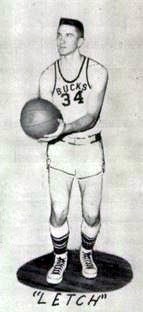 1955 – Class B – Buchanan 60, St. Joseph 57
1955 – Class B – Buchanan 60, St. Joseph 57
“It took two years but Jim Letcher got sweet revenge for a foul committed late in the district final in 1953 which gave the Bears a one point victory,” wrote Ed Lukas in the St. Joseph Herald Palladium. “Last night at the Buchanan gym, Letcher poured in 30 points to lead his Buck teammates to a 60-57 upset win over the highly touted St. Joseph Bears …”
The top rated team in Class B by the Detroit Free Press, St. Joseph had beaten Buchanan in both regular-season meetings. The winner of this matchup was expected to emerge as District champion. Indeed, Buchanan did just that, but barely, with a 47-45 win over Dowagiac. The Bucks rode the victories to the state finals, their first trip to the title game since 1928, before falling to River Rouge, 51-48, ending the year with a 17-7 mark.
1965 – Class C – Fowlerville 59, Portland 58
“Fowlerville, which did not have a winning record during the regular season, came up with the first major upset of the state high school basketball tournament Thursday night by edging previously unbeaten and top-ranked Portland, 59-58, in a Class C district … at Sexton,” wrote Ernie Boone for the Lansing State Journal. “Greg Braun, who only had six points all night and just one in the final period when Fowlerville took over the lead, sank a free throw with five seconds remaining to provide the winning margin.”
Fowlerville’s tournament run ended that Saturday as Williamston sank six free throws in the last two minutes of the District Final to emerge with a 48-46 win.
1969 – Class D – Detroit All Saints 62, Wyandotte Mt. Carmel 60, OT
“A perfect season and dreams of a state Class D basketball title went up in smoke Wednesday night before 3,000 fans for Wyandotte Mt. Carmel,” said Hal Schram in the Detroit Free Press. “Winner of 15 straight games and rated No. 1 among state powers in its division, Mt. Carmel bowed to old tormentor All Saints, 62-60, in a frenzied overtime period.
“Mt. Carmel has lost only three games in two seasons. All three losses came at the hands of the Saints.”
Detroit All Saints, reigning Class C state champ and ranked No. 3 by Schram, grabbed the District title before falling in the opening round of the Regionals to unranked Ypsilanti St. John, 65-62. Bob Sutton led all scorers with 21 for St. John in what was the upset of the tournament to that point. The Saints finished the year at 18-2.
1979 – Class A – Detroit Northeastern 95, Detroit Murray-Wright 91, OT
“Crash!! Murray-Wright High became the first big casualty of the 1979 state basketball tournament Tuesday night when the highly favored Pilots of coach George Duncan fell before underdog Northeastern, 95-91, in overtime at Highland Park High,” wrote Schram in the Free Press, describing the mayhem of the opening round to the District.
“Murray-Wright went into the game champion of Detroit’s Public School League and rated Michigan’s No 1 Class A team. But its 19-game winning streak ended when Joe Rodgers hit four straight free throws in the final 25 seconds of overtime to give the Falcons their most prized victory of the season.
“The Northeastern victory rubbed out another whirlwind comeback by Murray-Wright, which had to score 34 points in the final period to tie the game. … With 1:11 left in regulation, Northeastern led, 85-78, but the Pilots tied it with seven seconds left on Anthony White’s basket.”
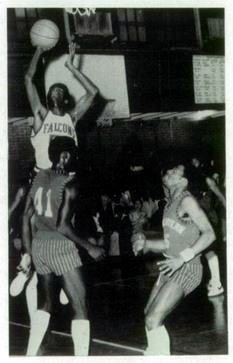 The likelihood of a rocky road to the title game for Murray-Wright was identified by Schram earlier in his write-up that accompanied his final regular-season ‘Top Ten’ rankings, a feature of the Free Press that dated back to the late 1940s. “There’s a dozen or so teams in Class A who could wind up with the big trophy. … Murray-Wright just might not get out of its own District where it has to meet and beat the likes of Northeastern, Highland Park or Northwestern.”
The likelihood of a rocky road to the title game for Murray-Wright was identified by Schram earlier in his write-up that accompanied his final regular-season ‘Top Ten’ rankings, a feature of the Free Press that dated back to the late 1940s. “There’s a dozen or so teams in Class A who could wind up with the big trophy. … Murray-Wright just might not get out of its own District where it has to meet and beat the likes of Northeastern, Highland Park or Northwestern.”
Much to the surprise of all the state’s prognosticators, unheralded Detroit Mackenzie, sporting a lackluster 13-7 regular-season mark, and preparing to celebrate its 50th graduating class that June, also got to celebrate its first basketball state title by downing Pontiac Central, 72-64, for the Class A crown.
1982 – Class C – Orchard Lake St. Mary 63, Redford St. Mary 55
“Orchard Lake St. Mary held off a late Redford St. Mary rally Monday night to defeat the No. 1 rated team in Class C, 63-55, in the first game of district play,” said Mick McCabe from the Free Press.
“Orchard Lake … jumped out to a 26-21 halftime lead despite the Rustics’ domination of the boards in the first half. Late in the third quarter, the Eaglets built up a 19-point lead but failed to deliver the knockout punch by missing a pair of wide open lay-ups before Redford scored the final five points of the period.”
Despite two losses – to Birmingham Brother Rice and Harper Woods Bishop Gallagher – The Associated Press and Detroit Free Press had ranked Redford St. Mary No. 1 in the state. With three losses – including a 79-77 defeat to Class A Detroit Cooley decided during the final 25 seconds – Orchard Lake St. Mary sat No. 2 in the Free Press’ final poll, while AP had the Eaglets at No. 4.
Orchard Lake led by 14 midway through the final frame, but Redford went on a 9-0 run to pull within five before running out of steam. Chris Howze scored 20 points on 8 of 12 shooting from the field to lead Orchard Lake to victory. Following the win, the Eaglets tore through Class C mostly uncontested until the Semifinals. Trailing by as many as 17 in the first half, Grand Rapids South Christian, a final four contestant in the previous two years, capitalized on the loss of Howze to fouls with 5:57 to play. Able to cut the margin to three with 21 seconds remaining, the Sailors couldn’t complete the furious comeback, and fell, 66-63. Orchard Lake coasted to the crown Saturday, thumping unranked Reed City, 76-48.
1995 – Class D – Detroit Holy Redeemer 75, Detroit East Catholic 66
“Hamtramck St. Florian will host the state’s second-best (opening round District) game when Detroit East Catholic (No. 1 in Class D) and Detroit Holy Redeemer hook up again,” noted McCabe in his pre-tournament column in the Free Press. “In the (Detroit) Catholic League semifinals, East Catholic got off to a huge lead against Redeemer and then hung for the victory.”
(The state’s top District opener, referred to by McCabe, ended as expected. Detroit Country Day, ranked No. 1 in the Free Press Class B rankings, rolled to an easy 55-48 victory over Orchard Lake St. Mary, the state’s No. 3 team. Sophomore Shane Battier scored 28, grabbed 11 rebounds and blocked three shots.)
McCabe had noted Redeemer’s senior guard Jimmy Reyes hadn’t played that well in the Catholic League final. Reyes certainly had his game in the rematch as he scored 20 points, including 13 in the fourth quarter, to lead the No. 6-ranked Lions to victory. Sophomore guard Armelius Parker added 17 as Holy Redeemer began its march to the Class D title.
The rivalry between the schools would continue in the coming years. Redeemer would again knock East Catholic out of the postseason in the District Final in 1996. East Catholic extracted some revenge in 1997, downing the Lions in the second round of the District, en route to its eighth and final MHSAA basketball championship. Both schools would close following the 2004-05 school year.
1997 – Class C – Benzie Central 73, Manton 70
In the opening game of the District 91 doubleheader, played at Benzonia, senior Nate Myers bagged eight 3-pointers, including the game winner with eight seconds remaining, as Benzie Central downed unbeaten and top-ranked Manton in the Class C District opener, 73-70. Benzie had lost an 11-point lead over the final four minutes.
“The gym was unbelievably full,” recalled Bill Lynch, a former coach at Benzie Central. “Just a great crowd. As I recall, Manton didn’t come down early to practice in the gym. I thought that was a mistake.”
Following the victory, Benzie Central cruised to the Semifinals before falling to Three Oaks River Valley in a frenzied 67-65 thriller. Trailing by 14, River Valley rallied back and was up three, 65-62, when Myers again bagged a clutch triple with just 11 seconds remaining to knot the game. But Zac Robinson would emerge as the game’s hero with a lay-up with 3.1 seconds remaining that hung on the rim “for an agonizing split second” before dropping through the net, ending Benzie Central’s dream run.
2004 – Class A – Grosse Pointe North 66, Detroit Denby 51
“Out of all the teams, that was the one team I was really concerned with,” said Detroit Denby coach Ray Reeves to McCabe about the draw of his team’s opponent prior to its Class A District opener with No. 9 Grosse Pointe North. “We beat them last year by 14, but it was a tough game. We made them play our style, and it wore them down.”
His concerns were warranted. Trailing by six to open the final quarter, North’s Mark Bramos scored 15 of his 25 points in the fourth as North toppled No. 1 Denby, 66-51, in Class A opening round District action.
“We saw them play Renaissance at Cobo, and that helped us a lot,” said guard Bryan Bennett, who scored 11 points for North. The Norsemen won the District, downing two more PSL squads Southeastern and Finney, but lost to eventual quarterfinalist Utica Eisenhower, 56-52, in their Regional opener.
 Ron Pesch has taken an active role in researching the history of MHSAA events since 1985 and began writing for MHSAA Finals programs in 1986, adding additional features and "flashbacks" in 1992. He inherited the title of MHSAA historian from the late Dick Kishpaugh following the 1993-94 school year, and resides in Muskegon. Contact him at [email protected] with ideas for historical articles.
Ron Pesch has taken an active role in researching the history of MHSAA events since 1985 and began writing for MHSAA Finals programs in 1986, adding additional features and "flashbacks" in 1992. He inherited the title of MHSAA historian from the late Dick Kishpaugh following the 1993-94 school year, and resides in Muskegon. Contact him at [email protected] with ideas for historical articles.
PHOTOS: (Top) Benzie Central’s Nate Myers drives between Three Oaks River Valley defenders in 1997. (Middle top) Muskegon Western Michigan Christian’s Gordon DeKruyter in 1952. (Middle) Buchanan’s Jim Letcher in 1955. (Middle below) Fowlerville’s 1965 team. (Below) Detroit Northeastern’s Joe Rogers puts up a shot in 1979. (Photos courtesy of Ron Pesch.)

2018-19 Stacking Up With Best on Records
March 29, 2019
By Ron Pesch
Special for Second Half
What a sports year.
There certainly have been some amazing athletic feats over the 2018-19 high school season in Michigan, and it’s just two-thirds of the way complete.
This past fall, Kobe Clark of Schoolcraft scored nine touchdowns in a single game. Stunning!
The winter sports season saw Dylan Jergens of Marcellus Howardsville Christian top the MHSAA single season scoring record in boys basketball, finishing with 971 points. Incredible!
Then a freshman, Emoni Bates, hits for 31 points in an MHSAA Semifinal for Ypsilanti Lincoln. Wow!
So, how does that compare to years past?
First, let’s hit the pool!
SWIMMING
Across the world, as well as in Michigan, record performances seem to fall regularly in swimming. I’m certainly no expert on the sport, but research seems to indicate that optimization of stroke count, kicks and other body positioning (and not a change in the density of H2O) impact the lowering of recorded times in the water. The continued synchronization and optimization of movement may mean we’ll see regular improvement for years to come.
It’s telling that MHSAA all class/division records in eight of the 12 events that make up a girls meet have been set this decade. The remaining four marks date to 2002 or 2007, and are held by Kara Lynn Joyce of Ann Arbor Pioneer or Allison Schmitt of Canton. Joyce, of course, went on to post 18 NCAA championships and four silver medals won during three Olympic competitions. A freestyle specialist, Schmitt won eight Olympic medals across the 2008, 2012 and 2016 games.
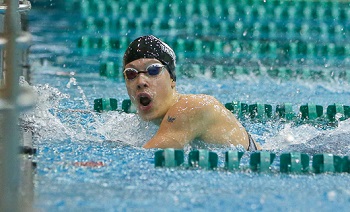 This past fall, the triumphs of three athletes, in particular, stand out. Kathryn Ackerman set a new state mark in the 200 individual medley with a time of 1:57:25. A junior, Ackerman’s time should place nationally in the top 15 all-time. With the 2018 season complete, she now holds the top four times in the event according to the MHSAA record book.
This past fall, the triumphs of three athletes, in particular, stand out. Kathryn Ackerman set a new state mark in the 200 individual medley with a time of 1:57:25. A junior, Ackerman’s time should place nationally in the top 15 all-time. With the 2018 season complete, she now holds the top four times in the event according to the MHSAA record book.
Senior Ashley Turak sprinted to a new Division I record of 22.10 in the 50 freestyle for Harrison/Farmington on the first leg of the 200 freestyle relay, as well as a time of 22.20 in the 50 freestyle. Both those times also rank in the national record books within the top 15. The MHSAA All-Class/Division Final Meet mark still belongs to Joyce, who posted a time of 22.04, set while leading off the 200 freestyle relay team in the Class A 2002 preliminaries.
Turak again mesmerized the crowd, this time in the 100-yard freestyle, posting a time of 48.72 seconds to win the event. Again, Joyce holds the Michigan All-Class/Division mark with a then-national record time of 48:59 set in 2002.
This November, Grand Ledge junior Lola Mull fell less than a half-second short of her own state mark in the 500-yard freestyle, set in the 2017 preliminaries. Mull owns the state’s top three times in the event, while Schmitt ranks fourth on the list.
Sub 20
A winter sport in Michigan, boys swimming is no different, with records in 10 of the 12 events set in the 2010s. Cam Peel of Spring Lake became the first in state history to break 20 seconds in the 50-yard freestyle, accomplishing the milestone twice this March, first in the prelim race with a record time of 19.86 and again in the finals at 19.91. The marks surpassed the previous best, set by Henry Schutte of Grand Rapids Forest Hills Central one year ago, and also rank among the “Best of the Best” in the National Federation record book.
FOOTBALL
Clark’s nine touchdowns came in Schoolcraft’s 63-27 victory over previously undefeated Constantine in a Southwestern Athletic Conference contest. Thanks to steady rain in the first half, Schoolcraft stuck to the ground game, opening a 21-0 first quarter lead on three Clark touchdowns, one of eight yards, the second of 24, and the third of 10 yards. Constantine battled back to within eight points, 21-13 late in the second quarter, but Clark would score for Schoolcraft twice more during the final three minutes before halftime.
 Following a 24-yard scamper, a partially blocked punt would set up Clark’s fifth rushing TD from two yards out with under a minute remaining before the break. (This appears to be a great moment to note that five players have scored five touchdowns in a single quarter). Clark added two TDs in the third quarter and two in the fourth.
Following a 24-yard scamper, a partially blocked punt would set up Clark’s fifth rushing TD from two yards out with under a minute remaining before the break. (This appears to be a great moment to note that five players have scored five touchdowns in a single quarter). Clark added two TDs in the third quarter and two in the fourth.
Amazingly, Clark’s nine touchdowns and 54 points scored are not state records. In fact, two others have matched the touchdown and point count, while three others have exceeded the accomplishment in each category. Of course, each of those events occurred at least 90 years ago, decades before the introduction of the mercy rule in high school football.
For many years, Herb Dunphy was listed as the state’s record holder for a pair of seemingly untouchable records: touchdowns in a single game and points scored in a game. In 1917 he scored 10 TDs for Lansing Central and stood alone at the top.
But as time has proven again and again, the work of historians and researchers can alter what we believe. In 1986, research by Tom Pellow of Gwinn uncovered that Marmaduke “Duke” Christie of Escanaba had also scored 10 touchdowns, matching Dunphy’s output. In addition, Christie added six point-after-touchdowns that day, totaling 66 points, as Escanaba defeated Ishpeming 102-0 in November 1920.
“In my humble opinion, Escanaba high school in 1920 had one of the greatest football teams that ever misunderstood a signal in any language,” wrote Cy DeLynes, recalling the exploits of Christie and his teammates in the Escanaba Daily Press in 1929. “Christie was its captain. The Duke had a pair of collapsible ankles and he was able to play in only a part of four games. That, however, was just enough time to permit him to score 21 touchdowns and 38 out of a possible 50 points after touchdown – a total of 164 points. He led a backfield that made Knute Rockne’s Four Horsemen look like a quartet of super-annuated milk wagon drivers turning off the alarm clocks at 4 o’clock in the morning.”
A few years later, additional study of yearbooks and newspapers revealed the exploits of Cecil Hardy of Flint Central, again reshaping the scoring entries in the MHSAA record book.
In the 1914 season opener – a 106-0 blasting of Lapeer – Hardy carried for more than 300 yards. Within the first two minutes of play, the captain of the Flint squad had scored the first of 11 touchdowns – a “new” state mark.
“His end running was the feature of the game, his longest run being one for 50 yards and a touchdown on the first play after the kickoff. Time after time as he was making his long runs he appeared to be tackled and would wriggle out of the grasp of his opponent and run 15 or 20 yards further,” was the report of the day.
“How Is This For Football?”
Muskegon 216, Hastings 0
The Boston Globe paired the question with the football score from a Michigan high school game to readers in their Sunday edition back on September 29, 1912.
“Most of Muskegon’s touchdowns were scored on the kick-off,” stated the Globe, “and few required more than one down.”
The score was believed to be a “world’s record” for points scored in a game, at the time. Indeed, the total ranks as the tops in Michigan. Indeed, it was a record nationally, but would be surpassed on three occasions in the coming years, first in 1923, again in 1924 and finally in 1927. With today’s employment of the running clock, the scoring totals will never again be approached.
The score was 40-0 at the end of the first quarter, 102-0 following the second, and 150-0 after three quarters. Touchdowns were scored by nine different players, with six scoring multiple times. As byproducts, captain Fred Jacks finished with nine touchdowns, while Muskegon’s Nelson Stuit booted 24 of 30 extra points in the contest (another state mark that also will never be equaled).
“Although world’s records fell in the game it is not anything to be particularly proud of …” stated the Muskegon Chronicle in the prose of the time. “The visitors had about three men that knew a football from an eff, and those three could not make the Muskegon second team.”
One of the best, as it turned out, was Fred Rehor, Hastings’ “big 220 pound fullback” who would later play for Michigan, then professional ball in Ohio for the 1917 Massillon Tigers, coached by Knute Rockne.
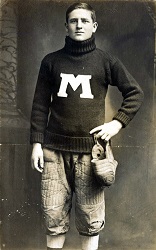 As a result of the Muskegon-Hastings game, “at least three of the football elevens which contracted this year to meet Muskegon high school have begun to make excuses in line with those usually offered before a team quits such an engagement,” wrote the Lansing State Journal. Muskegon rolled up 499 points on the year, but ended a flawless season in defeat, 13-12 against rival Grand Rapids Central in the finale. The loss was blamed on overconfidence.
As a result of the Muskegon-Hastings game, “at least three of the football elevens which contracted this year to meet Muskegon high school have begun to make excuses in line with those usually offered before a team quits such an engagement,” wrote the Lansing State Journal. Muskegon rolled up 499 points on the year, but ended a flawless season in defeat, 13-12 against rival Grand Rapids Central in the finale. The loss was blamed on overconfidence.
The aptly named Francis Tallent of Menominee, became the next player to score nine TDs in a game.
Tallent’s skills on the gridiron had been spotted in 1928.
“Standing out like a missing tooth in a front row of the chorus … (Tallent) revealed as speedy a pair of heels as one could ever hope to cast his optics on in a high school game,” wrote one reporter after witnessing the left halfback’s performance in the annual twin cities battle between Menominee and Marinette, Wis., then played on Armistice day. Tallent scored twice in that “M & M” game, a 26-0 win by Menominee.
After thumping Green Bay in its 1929 season opener and a “helpless” Oshkosh Normal (now known as the University of Wisconsin-Oshkosh) freshmen team, 46-6, Menominee squared off for its game against “a light and green squad” from Kingsford.
According to the Milwaukee Journal Sentinel, Tallent scored nine touchdowns that day on runs of 46, 72, 90, 64, 50, 37, 90, 85 and 63 yards. In total, the paper noted that Tallent gained 597 yards rushing in the 150-0 thrashing of Kingsford. Other sources noted that it was likely more, as the sum of only the TD runs equaled the 597 yard total. Kingsford would finish its seven-game season without scoring a point. According to the Kingsfordian, the school’s high school annual, the Kingsford players “were no match for the heavier and more experienced teams on the range” that school year.
Menominee’s success and Tallent’s football exploits prompted the Journal-Sentinel to send a reporter to the U.P. to cover the 1929 M & M game between the border schools later that fall. “Mr. Tallent, who runs like the well-known hare and who slips out of tacklers’ arms and hands like a piece of wet soap, scored four touchdowns in the course of the afternoon,” wrote the staffer. “All told, this Mr. Tallent rolled up 284 yards,” as the “pride of the peninsula walloped Marinette,” 49-0, before a crowd of 10,000. The score was “the highest ever piled up in 45 years of bitter rivalry between the two cities.”
Menominee ended the 1929 season undefeated and untied in eight games, scoring over a point-a-minute while claiming the Upper Peninsula championship and demanding statewide consideration for Michigan’s mythical crown. Tallent finished the season with 27 touchdowns.
BASKETBALL
After 35 years, one began to wonder if Mark Brown’s single-season scoring mark, set in 1984-85 during his days at Hastings, would ever be surpassed. Brad Redford, named Michigan’s Mr. Basketball, came close as a senior in 2007-08, falling 17 points shy of exceeding Brown’s total of 969. Prior to that, only Drew Neitzel of Wyoming Park had come within reasonable striking distance, but that happened a decade and a half ago.
This year, Jergens of Howardsville Christian finally topped the total, finishing with 971 points. Jergens accomplished the task in 24 games, two games fewer than Brown, but with the advantage of the 3-point shot. The three was implemented after Brown had headed to college. According to press reports, Jergens had four games of at least 50 points during the season.
Still standing, 40 years later, is Jay Smith’s high school career scoring mark of 2,841 points, set at Mio between 1976 and 1979. Jergens finished third on the list with 2,782 career points, including 320 career 3-pointers – second most in state history. Brown ranks second with 2,789 points scored between 1982 and 1985.
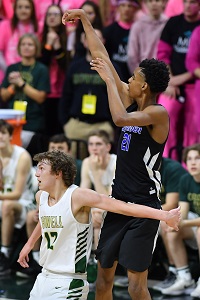 Freshmen
Freshmen
Few followers of prep basketball in Michigan could avoid coming across the name Emoni Bates, especially after the freshman phenom from Ypsilanti Lincoln knocked down 17 points in the Quarterfinals, 31 points in the Semifinal round of the Division 1 tournament, then 23 in the championship game. The immediate question on press row was, “Had another ninth grader ever exceeded his totals in a MHSAA final-rounds contests?” There was nothing to exceed it that I could recall.
While we’ve kept final round records, including single-game scoring marks, the website minimum is 40 points, and we’ve never captured a list that’s broken down by year in school.
So, I decided to dig.
Quarterfinals
The state has certainly seen some talented freshmen pass through the last rounds of the tournament. Monte Morris scored 20 points in the Quarterfinals for Flint Beecher during its Class C run in 2010. Saginaw Buena Vista played two freshmen, Mark Macon and Shawn Randolph, along its route to the Finals in 1984. Macon, at the age of 14, scored 22 points in a Quarterfinal win over Menominee that season. Two players scored 24 points in the quarters as freshmen: Flint Beecher’s Roy Marble, Jr. in 1982 in a loss to Okemos and Manton’s Matt Stuck, who scored 24 in defeat against Mio in 1989. But, according to Detroit Free Press accounts, it appears Michael Payton from Detroit St. Leo is the leading freshman point-getter in the Quarterfinal round. Payton netted 26 in a 74-62 loss to Flint St. Redeemer in the 1970 tournament.
Semifinals
Macon in 1984 and perhaps the most famous of freshmen in MHSAA Tournament history, Willie Betts of River Rouge in 1961, both scored 14 in Semifinal victories. Clyde Corley from Pontiac Central tossed in 16 points during a heartbreaking Semifinal defeat, 53-52, to Saginaw in 1976. Kelvin Torbert posted 17 points (and 10 rebounds) in a 65-62 Semifinal loss to Belleville in 1998. Morris tallied 18 in a loss to Melvindale Academy for Business & Technology in the Class C semis in 2010. So, Bates’ total of 31 certainly appears to top the list.
Finals
Only one freshman prior to Bates has hit for double digits in a state final. In 1992, Saginaw Buena Vista’s Terrance Roberson went 3 for 7 from the field and 4 for 7 from the free throw line to finish with 10 points as the Knights grabbed a 54-44 win over Grandville Calvin Christian.
Please, let me know if I missed a top performer.
 Ron Pesch has taken an active role in researching the history of MHSAA events since 1985 and began writing for MHSAA Finals programs in 1986, adding additional features and "flashbacks" in 1992. He inherited the title of MHSAA historian from the late Dick Kishpaugh following the 1993-94 school year, and resides in Muskegon. Contact him at [email protected] with ideas for historical articles.
Ron Pesch has taken an active role in researching the history of MHSAA events since 1985 and began writing for MHSAA Finals programs in 1986, adding additional features and "flashbacks" in 1992. He inherited the title of MHSAA historian from the late Dick Kishpaugh following the 1993-94 school year, and resides in Muskegon. Contact him at [email protected] with ideas for historical articles.
PHOTOS: (Top) Grand Haven’s Kathryn Ackerman swims the breaststroke portion of her record-setting 200-yard individual medley this past fall. (Top middle) Harrison-Farmington’s Ashley Turak looks to the clock after her 100 freestyle at the Lower Peninsula Division 1 Finals. (Middle) Schoolcraft’s Kobe Clark. (Middle below) Muskegon's Fred Jacks. (Below) Ypsilanti Lincoln’s Emoni Bates fires a jumper during his team’s Division 1 Semifinal win over Howell

